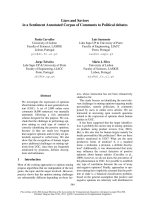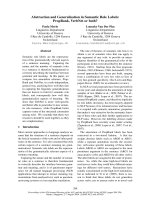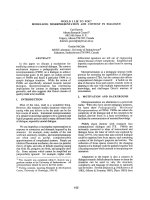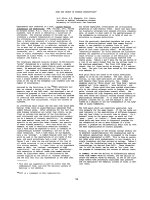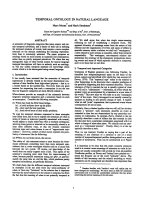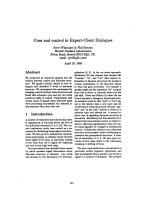Báo cáo khoa học: "UNGRAMHATICALITY AND EXTRA-GRAMMATICALITY IN NATURAL LANGUAGE UNDERSTANDING SYSTEMS" docx
Bạn đang xem bản rút gọn của tài liệu. Xem và tải ngay bản đầy đủ của tài liệu tại đây (476.59 KB, 6 trang )
UNGRAMHATICALITY AND EXTRA-GRAMMATICALITY IN NATURAL LANGUAGE UNDERSTANDING SYSTEMS
Stan C. Kwasny as
The Ohio State University
Columbus, Ohio
1. Introduction
Among the components included in Natural Language
Understanding (NLU) systems is a grammar which specifies
much of the linguistic structure of the utterances that
can be expected. However, it is certain that inputs
that are ill-formed with respect to the grammar will be
received, both because people regularly
form
ungra=cmatical utterances and because there are a variety
of forms that cannot be readily included in current
grammatical models and are hence "extra-grammatical".
These
might be rejected, but
as
Wilks stresses,
" understanding requires, at the very least, some
attempt to interpret, rather than merely reject, what
seem to be ill-formed utterances." [WIL76]
This paper investigates several language phenomena
commonly considered ungrammatical or extra-grammatical
and proposes techniques directed at integrating them as
much as possible into the conventional grammatical
processing performed by NLU systems through Augmented
Transition Network (ATN) grammars. For each NLU system,
a "normative" grammar is assumed which specifies the
structure of well-formed inputs. Rules that are both
manually added to the original grammar or automatically
constructed during parsing analyze the ill-formed input.
The ill-formedness is shown at the completion of a parse
by deviance from fully grammatical structures. We have
been able
to
do this processing while preserving the
structural characteristics of the original
grammar
and
its inherent efficiency.
Some of the phenomena discussed have been
considered previously in particular NLU systems, see for
example the ellipsis handling in LIFER [HEN??]. Some
techniques similar to ours have been used for parsing,
see for example the conjunction mechanism in
LUNAR
[WOO?3). On the linguistic side, Chomsky [CHO6q] and
Katz [KAT6q], among others have considered the treatment
of ungrammatlcality in Transformational Grammar
theories. The study closest to ours is that of
Weischedel
and Black [WEI?9]. The present study is
distinguished
by the range
of
phenomena considered, its
structural and efficiency goals, and the inclusion of
the techniques proposed within one implementation.
This paper looks at these problems, proposes
mechanisms aimed at solving the problems, and describes
how these mechanisms are used. At the end, some
extensions are suggested. Unless otherwise noted, all
ideas have been tested through implementation. A more
detailed and extended
discussion of
all
points may
be
found
in
Kwasny [KWA?9].
II.
Language Phenomena
Success in handling ungrammatical and
extra-grammatical input depends on two factors. The
first is the identification of types of ill-formednese
and the patterns they follow. The second is the
relating of ill-formed input to the parsing path of a
grammatical input the user intends. This section
introduces the types of ill-formedness we have studied,
ee Current Address:
Computer Science Department
Indiana University
Bloomington, Indiana
By
Norman K. Sondheimer
Sperry Univac
Blue Bell, Pennsylvania
and discusses their relationship
structures
in
terms of ATN grammars.
to
grammatical
II.I Co-Occurrence Violations
Our first class of errors can be connected to
co-occurrence
restrictions within
a sentence. There are
many occassions in a sentence where two parts or more
must agree (= indicates an ill-formed or ungrammatical
sentence):
=Draw
a
circles.
"I will stay from now under midnight.
The errors in the above involve coordination between the
underlined
words. The
first example illustrates simple
agreement
problems.
The second
involves
a
complicated
relation between at least the three underlined terms.
Such phenomena do occur naturally. For example,
Shore
($H077] analyzes
fifty-six
freshman English papers
written by Black college students and reveals patterns
of nonstandard usage ranging from uninflected plurals,
possessives, and third person singulars to
overinflection (use of inappropriate endings.)
For co-occurrence violations, the blocks that keep
inputs from being parsed as the user intended arise from
a failure of a test on an arc or the failure to satisfy
an arc type restriction, e.g., failure of a word to be
in the correct category. The essential block in the
first example would likely occur on an agreement test on
an arc accepting a noun, The essential blockage in the
second example
is likely to
come from
failure
of the
arc
testing
the
final preposition.
11.2 Ellipsis
and Extraneous Terms
In handling ellipsis, the most relevant distinction
to make is between contextual and telegraphic ellipsis.
Contextual ellipsis occurs when a form only makes
proper sense in the context of other sentences. For
example, the form
ePresident
Carter
has.
seems ungrammatical without the preceding question form
Who has a daughter named Amy?
President Carter has.
Telegraphic ellipsis, on the other hand, occurs
when a form only makes proper sense in a
particular
situation. For example, the tome
3 chairs no waiting (sign in barber shop)
Yanks split (headline in sports section)
Profit margins for each product
(query
submitted to
a
NLU
system)
19
are cases of telegraphic ellipsis with the situation
noted In parentheses. The final example Is from an
experimental study
of
NLU
for
management information
which indicated that such forms must be considered
[MAL75].
Another type of unarammaticality related to
ellipsis occurs when the user puts unnecessary words or
phrases In an utterance. The reason for an extra word
may be a change of intention In the middle of an
utterance, an oversight, or simply for emphasis. For
example,
• Draw a llne with from here to there.
"List prices of single unit prices for 72 and 73.
The second example comes from Malhotra [MALT5].
The best way to see the errors
In
terms of the
ATN
is to think of the user as trylng to complete a path
through the grammar, but having produced an input that
has too many or too few forms necessary to traverse all
arcs,
II.3
Conjunction
Conjunction is an extremely common phenomenon, but
it is seldom directly treated in 8 grammar. We have
considered several typos of conjunction.
Simple forms of conjunction occur most frequently,
as in
John loves Mary and hates Sue.
Gapping occurs when internal segments of the second
conjunct are missina, as
in
John loves Mary and Wary John.
The list form of conjunction occurs when more than two
elements are joined in a single phrase, as in
John loves Wary. Sue, Nancy. end Bill.
Correlative
conjunction occurs in sentences to
coordinate the Joining of constituents, as in
John both loves and hates Sue.
The reason conJuncts are generally left out of
grammars is that they can appear in so many places that
inclusion would dramatically increase the size of the
grammar. The same argument applies
to the
ungrammatical
phenomena. Since they allow so much variation compared
to grammatical forms, including them with existing
techniques would dramatically increase the size oF a
gram~aar.
Further there is a real distinction in terms
of completeness
and
clarity of intent
between
grammatical and ungrammatical forms. Hence we feel
justified In suggesting speciai techniques
for
their
treatment.
III. Proposed Mechanisms and How They Apply
The following presentation of our techniques
assumes an understanding of the
ATN
model. The
techniques are
applied
to the
langumae phenomena
discussed
~n the previous
section.
20
III.l Relaxation Techniques
The first two methods described are relaxation
methods which allow the successful traversal of ATN arcs
that miaht not otherwise be traversed. Durin8 parsina,
whenever an arc cannot be taken, a check is made to see
if some form of relaxation can apply. If it can. then a
backtrack point is created which includes the relaxed
version of the arc. These alternatives are not
considered until after all possible 8rammatlcsl paths
have been attempted thereby insurtn8 that 8rammaticel
inputs are still handled correctly. Relaxation of
previously relaxed arcs is also possible. Two methods
of relaxation have been Investigated.
Our first method involves relaxln8 a test on an
arc, similar to the method used by Weisohedel in
[WEI79]. Test relaxation occurs when the test portion
of an arc contains a relaxable predicate and the test
fails. Two methods of test relaxation have been
identified and implemented based on predicate type.
Predicates can be desianated by the grammar writer as
either absolutely violable in which case the opposite
value of the predicate (determined by the LISP function
NOT applied to the predicate) Is substituted for the
predicate during relaxation or conditionally violable in
which case s substitute predicate is provided. For
example, consider the following to be a test that fails:
(AND
(INFLECTING V)
(INTRAN3
V))
If the predicate INFLECTING was declared absolutely
violable and its use in this test returned the value
NIL, then the negation of (INFLECTING Y) would replace
It in the test creating a new arc with the test:
(AND
T
(INTRANS
V))
If INTRANS were conditionally violable with the
substitute predicate TRANS, then the following test
would appear on the new arc:
(AND
(INFLECTING V)
(TRANS
V))
Whenever more than one test in a failing arc is
violable, all possible single relaxations are attempted
independently. Absolutely violable predicates can be
permitted in cases where the test describes some
superficial consistency checking or where the test's
failure or success doesn't have a direct affect on
meaning, while conditionally violable predicates apply
to predicates which must be relaxed cautiously or else
loss
of meaning may
result.
ChomsMy discusses the notion of organizing word
categories hierarchically in developing
his
ideas on
degrees
of
grammaticalness. We have applied and
extended
these
ideas In our second method of relaxation
called catesory relaxation. In this method, the 8rammar
writer produces, along with the grammar, a hierarchy
describing the relationship amen8 words, categories, and
phrase types which is utilized by the relaxation
mechanism to construct relaxed versions of arcs that
hive failed. When an
arc
fails because of an
arc type
failure (i.e., because a particular word, category, or
phrase was not found) a new arc (or arcs) may be created
according to the description of the word, category, or
phrase in the hierarchy. Typically. PUSH arcs will
relax to PUSH arcs, CAT arcs to CAT or PUSH arcs,
and
WRD or HEM arcs to
CAT
arcs. Consider. for example, the
syntactic cateaory hierarchy for pronouns shown in
Figure 1. For this example, the cateaory relaxation
mechanism would allow the relaxation of PERSONAL
pronouns to include the category PRONOUN. The arc
produced from category relaxation of PERSONAL pronouns
also includes the subcategories REFLEXIVE and
DEMONSTRATIVE in order to expand the scope of terms
during relaxation. As with test relaxation, successive
relaxations could occur.
For both methods of relaxation, "deviance notes"
are generated which describe the nature of the
relaxation in each case. Where multiple types or
multiple levels of relaxation occur, a note is generated
for each of these. The entire list of deviance notes
accompanies the final structure produced by the parser.
In this way, the final structure is marked as deviant
and the nature of the deviance is available for use by
other components of the understanding system.
In our implementation, test relaxation has
been
fully implemented, while category relaxation has been
implemented for all cases except those involving PUSH
arcs. Such an implementation is anticipated, but
requires a modification to our backtracking algorithm.
III.2 Co-Occurrence
and Relaxation
The solution being proposed to handled forms that
are deviant because of co-occurrence violations centers
around the use of relaxation methods. Where simple
tests exist within a grammar to filter out unacceptable
forms of the type noted above, these tests may be
relaxed to allow the acceptance of these forms. This
doesn't eliminate the need for such tests since these
tests help in disambiguation and provide a means by
which sentences are marked as having violated certain
rules.
For co-occurrence violations, the point in the
grammar where parsing becomes blocked is often exactly
where the test or category violation occurs. An arc at
that point is being attempted
and
fails due to
a
failure
of the co-occurrence test or categorization
requirements. Relaxation is then applied and an
alternative generated which
may be explored
at
a
later
point via backtracking. For example, the sentence:
WJohn love Mary
shows a disagreement between the subject (John) and the
verb (love). Most probably this would show up during
parsing when an arc is attempted which is expecting the
verb of the sentence. The test would fall and the
traversal would not be allowed. At that point, an
ungrammatical alternative is created for later
backtracking to consider.
III.) Patterns and the Pattern Arc
In this section, relaxation techniques, as
applied
to the grammar itself, are introduced through the use
of
patterns and pattern-matching algorithms. Other systems
have used patterns for parsing. We have devised a
powerful method of integrating, within the ATN
formalism, patterns which are flexible and useful.
In our current formulation, which we
have
implemented and are now testing, a pattern is a linear
sequence of ATN arcs which is matched against the input
string. A pattern arc (PAT) has been added to the ATN
formalism whose form is similar to that of other arcs:
(PAT <pat apec> <test> <act> a <term>)
The pattern specification (<pat spec>) is defined as:
<pat spec>
:::
(<patt>
<mode> a)
21
<part> ::= (<p arc>*)
<pat name>
<mode>
::= UNANCHOR
OPTIONAL
SKIP
<p arc>
::=
<arc>
> <arc>
<pat name> ::= user-assiGned pattern
name
>
The pattern (<part>) is either the name of a pattern, a
">", or a list of ATN arcs, each of which may be
preceded by the symbol ">", while the pattern mode
(<mode>) can be any of the keywords, UNANCHOR, OPTIONAL,
or SKIP. These are discussed below. To refer to
patterns by name, a dictionary of patterns is supported.
A dictionary of arcs is also supported, allowing the
referencing of arcs by name as well. Further, named
arcs are defined as macros, allowing the dictionary and
the grammar to be substantially reduced in size.
THE PATTERN MATCHER
Pattern matching proceeds by matching each arc in
the pattern against the input string, but is affected by
the chosen "mode" of matching. Since the individual
component arcs are, in a sense, complex patterns, the
ATN interpreter can be considered part of the matching
algorithm as well. In ares within patterns, explicit
transfer to a new state is ignored and the next arc
attempted on success is the one following in the
pattern. An are in a pattern prefaced by ">" can be
considered optional, if the OPTIONAL mode has been
selected to activate this feature. When this is done,
the matching algorithm still attempts to match optional
area, but may ignore them. A pattern unanchoring
capability is activated by specifying the mode UNANCHOR.
In this mode, patterns are permitted to skip words prior
to matching. Finally, selection of the SKIP mode
results in words being ignored between matches of the
arcs within a pattern. This is a generalization of the
UNANCHOR mode.
Pattern matching again results in deviance notes.
For patterns, they contain information necessary to
determine how matching succeeded.
SOURCE OF PATTERNS
An automatic pattern generation mechanism has been
implemented using the trace of the current execution
path to produce a pattern. This is invoked by using a
">" as the pattern name. Patterns produced in this
fashion contain only those arcs traversed at the current
level of recursion in the network, although we are
planning to implement a generalization o£ this in which
PUSH arcs can be automatically replaced by their
subnet~ork paths. Each are in an automatic pattern is
marked as optional. Patterns can also be constructed
dynamically in precisely the same way grammatical
structures are built using BUILDQ. The vehicle by which
this is accomplished is discussed next.
AUTOMATIC PRODUCTION OF ARCS
Pattern arcs enter the grammar in two ways. They
are manually written into the grammar in those cases
where the ungrammaticalities are common and they are
added to the grammar automatically in those cases where
the ungrammaticality is dependent on context. Pattern
arcs produced dynamically enter the grammar through one
of two devices. They may be constructed as needed by
special macro arcs or they may be constructed for future
use through an expectation mechanism.
As the expectatlon-based parsing efforts clearly
show,
syntactic elements especially
words contain
important clues on processing. Indeed. we also have
found
It useful to make the ATN mechanism more "active"
by allowing it to produce new arcs based on such clues.
TO achieve
this, the
CAT,
MEM,
TBT,
and
WRD
arcs have
been generalized and
four
new "macro" arcs, known as
CAT e. HEM e, TST a,
and
WRD e.
have been added to
the ATN
formalism. These are similar In every
way
to their
counterparts, except that as a final action, instead
of
indicating the state
to which
the
traversal leads, a new
arc
is oonstructed dynamically and immediately executed.
The difference in the form that the new arc takes is
seen in the following pair where <crest act> Is used to
define the dynamic arc:
(CAT <cat> <test> <act> a <term >)
(CAT e <cat> <test> <act> a <creat act>)
Arcs computed
by
macro arcs
can be
of
any
type permitted
by the
ATN,
but
one of the most useful arcs to compute
in this manner is the PAT arc discussed above.
EXPECTATIONS
The macro arc forces immediate execution of an arc.
Arcs may also be computed and temporarily added to the
grammar for
later
execution
through an "expectation"
mechanism. Expectations are performed as actions within
arcs (analogous
to
the HOLD action
for
parsing
structures) or as actions elsewhere In
the MLU
system
(e.g., during generation when particular types of
responses can be foreseen). Two forms are allowed:
(EXPECT <crest act> <state>)
(EXPECT <crest act> )
In the first case, the arc created is
bound to
a state
as specified. When later processing leads to that
state, the expected arc
will
be attempted as one
alternative at that state. In the second case, where no
state is specified, the effect is to attempt the arc at
every state visited
during
the parse.
The range
of
an expectation produced during parsing
is ordinarily
limited to
a single
sentence,
with the arc
disappearing after it has been used;
however,
the start
state, S e, is reserved for expectations intended to be
active at the beginning of the next sentence. These
will disappear in turn at the end ~prooessing for that
sentence.
IIZ.q Patterns t Elllpsls~
and
Extraneous Forms
The Pattern arc is proposed as the primary
mechanism for handling ellipsis and extraneous forms. A
Pattern arc can be seen as capturing a single path
through a netWOrk. The matcher gives some freedom In
how that path relates to a string. We propose that the
appropriate parsing path through a network relates to an
elliptical sentence or one with extra words in the same
way. With contextual ellipsis, the relationship will be
in having some of the arcs on the correct path not
satisfied.
In
Pattern arcs, these will
be
represented
by arcs marked as optional. With contextual ellipsis,
dialogue context will provide the defaults
for
the
missing components. With Pattern arcs, the deviance
notes will show what was left
out
and the other
components in the ~U system will be responsible for
supplying the values.
The source of patterns for contextual ellipsis is
important. In Lifer [HEN77],
the
previous user input
can be seen as a pattern for elliptical processing of
the current input. The automatic pattern generator
developed here, along with the expectation mechanism,
will capture this level of processing. But with the
ability to construct arbitrary patterns and to add them
to
the grammar from
other
components of
the
MLU system,
our approach can acccomplish much more. For example, a
question generation routine could add an expectation of
a yes/no answer in front of a transformed rephrasing of
a question, as in
Did
Amy
klas
anyone?
Yes,
Jismy
was kissed.
Patterns for telegraphic ellipsis will have to be
added to the grammar manually. Generally, patterns of
usage must be identified, say in a study like that of
Malhotra, so that appropriate patterns can be
constructed. Patterns for extraneous forms will also
be
added In advance. These will either use the unachor
option In order to skip false starts, or dynamically
produced patterns to catch repetitions for emphasis. In
general, only a limited number of these patterns should
be required. The value of the pattern mechanism here,
especially In the case
of
telegraphic ellipsis, will be
in connecting the ungrammatical to grammatical forms.
III.5
Conjunction and Macro Arcs
Pattern arcs are also proposed as the primary
mechanism for handling conjunction. The rationale for
this is the often noted connection between conjunction
and ellipsis, see for example Halltday and Haman
[HAL75]. This is clear with gapping, as in the
following where the parentheses show the missing
component
John loves Mary and Mary (loves) John.
BUt it also can be seen with other forms, as in
John loves Mary and (John) hates Sue.
John loves Hary, (John loves) Sue, (John loves)
Mancy, and (John loves) Bill.
Whenever a conjunction is seen, a pattern is developed
from the already identified elements and matched against
the remaining segments
of
input. The heuristics
for
deciding from which level to produce the pattern force
the most general interpretation in order to encourage an
elliptical reading.
All of the forms of conjunction described above are
treated through a globally defined set of "conjunction
arcs" (Some restricted cases, such as "and" following
"between", have the conjunction built into the grammar).
In general, this set will be made up of macro
arcs
which
compute Pattern arcs. The automatic pattern mechanism
is heavily used. With simple conjunctions, the
rightmost elements
in
the patterns are matched.
Internal elements In patterns are skipped with gapping.
The llst form of conjunction can also be handled through
the careful construction of dynamic patterns which are
then expected at a later point. Correlatives are
treated similarly, with expectations based
on
the
dynamic building of patterns.
There are a number of details in our proposal which
will not be presented. There are also visible limits.
it is instructive to compare the proposal to the SYSCONj
facility of Woods [W0073]. It treats conjunction as
22
showing alternative ways of continuing a sentence. This
allows for sentences such as
He
drove his car through
and
broke
a
plate glass
window.
which
at
best we will accept with
a
misleading
deviance
note. However, it can not handle the obvious elliptical
cases, such gapping, or the tightly constrained cases,
such as correlatives. We expect to continue
investigating the pattern approach.
III.6 Interaction of Techniques
As grammatical processing proceeds, ungrammatical
possibilities are continually being suggested from the
various mechanisms we have implemented. To coordinate
all of these activities, the backtracking mechanism has
been improved to keep track of the:le alternatives. All
paths in the original grammar are attempted first. Only
when these all fail are the conjunction alternatives
and
the
manually
added and dynamically produced
ungrammatical alternatives tried. All of the
alternatives of these sorts connected with a single
state can be thought of as a single possibility. A
selection mechanism is used to determine which backtrack
point among the many potential alternatives is worth
exploring next. Currently, we use a method also used by
Welschedel
and Black
[WEI79] of selecting the
alternative with the longest path length.
IV. Conclusion
and Open
Questions
These results are significant, we believe, because
they extend the state of the art in several ways. Most
obvious are
the
following:
The use of
the
category
hierarchy
to
handle
arc
type
failures;
The use of the pattern mechanism to allow for
contextual ellipsis and gapping;
More generally, the use of patterns to allow for
many
sorts of ellipsis
and
conjunctions;
and
Finally, the orchestration of all of the techniques
in one coherent system, where because all
grammatical alternatives are tried first and no
modifications are made to the original grammar, its
inherent efficiency and structure are preserved.
IV.1 Open Problems
Various questions for further research have arisen
during the course of this work. The most important of
these are discussed here.
Better control must be exercised over the selection
of viable alternatives when ungrammatical possibilities
are being attempted. The longest-path heuristic is
somewhat weak. The process that decides this would need
to take into consideration, among other things, whether
to allow relaxation of a criteria applied to the subject
or to the verb in a case where the subject and verb do
not agree. The current path length heuristic would
always relax the verb which is clearly not always
correct.
No consideration has been given to the possible
connection of one error wlth another. In some cases,
one error can lead to or affect another.
Several other types of ill-formedness have not been
considered in this study, for example, idioms,
metaphors, incorrect word order, run together sentences,
incorrect punctuation, misspelling, and presuppositional
failure. Either little is known about these processes
or they have been studied elsewhere independently. In
either case, work remains to be done.
V. Acknowledgments
We wish to acknowledge the comments of Ralph
Weischedel and Marc Fogel on previous drafts of this
paper. Although we would like to blame them,
any
shortcomings are clearly our own fault.
VI. Bibliography
[CHO6q]
[FOD64]
[HAL76]
(HEN77]
[KAT643
[KWA793
[MAL75]
[SHO77]
[WEI79]
[ WIL76 ]
[wo0733
Chomsky,
N.,
"Degrees of Grammaticalness," in
[FOD6~], 38q-389.
Fodor, J. A. and J. J. Katz, The Structure of
Language: Readings in the Philosophy of
Language, Prentice-Hall, Englewood Cliffs, New
Jersey, 196q.
Halliday, M.A.K. and R. Hasan, Cohesion in
English, Longman, London, 1976.
Hendrlx, G. G., "The LIFER Manual," Technical
Note 138, Artificial Intelligence Center,
Stanford Research Institute, Menlo Park,
California, February, 1977.
Katz, J.J., "Semi-Sentences," in [FOD64],
qoo-q16.
Kwasny, S., "Treatment of Ungrammatical and
Extragrammatical Phenomena in Natural Language
Understanding Systems,"
PhD
dissertation
(forthcoming), Ohio State University, 1979.
Malhotra, A.,
"Design
Criteria for
a
Knowledge-Based English Language System for
Management: An Experimental Analysis," MAC
TR-I~6, M.I.T., Cambridge, Ha, February, 1975.
Shores, D.L., "Black English and Black
Attitudes," in Papers in Language Variation.
D.L. Shores and C. PT-Hines (Ed ~. ] ~e
University
of Alabama
Press, University,
Alabama, 1977.
Weischedel,
R. M., and J. Black, "Responding
to
Potentially Unparseable Sentences," manuscript,
Department of Computer and Information
Sciences, University of Delaware, Newark,
Delaware,
1979.
Wilka, Y., "Natural Language Understanding
Systems Within the A.I. Paradigm: A Survey,"
American Journal of Computational Lin~uistlcs,
~h~-#-~
1T
1976.
Woods, W.
A2
"An Experimental Parsing System
for Transition Network Grammars," in Natural
Language Processing, R. Muslin (Ed.),
Algorithmlcs Press, 1973.
PRONOUN
REFLEXIVE
/;o i
he she yourself this that
Figure 1. A Category Hierarchy
23


